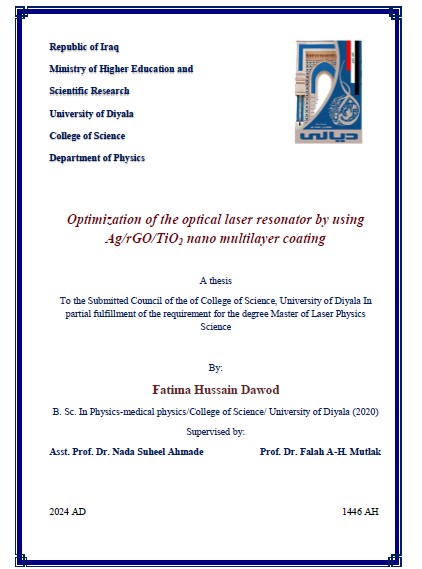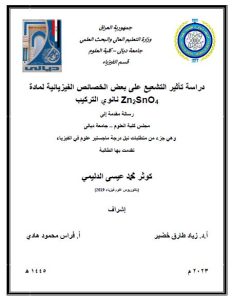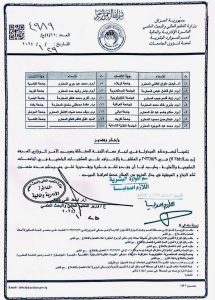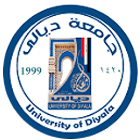ABSTRACT:
In this research, nanoparticles had been prepared via two methods. The first method is the co-precipitation method to prepare silver and rutile titanium dioxide; the second method is microwave-assisted combustion to prepare reduced graphene oxide nanoparticles. These methods are characterized by their simplicity and the rapid acquisition of nanoparticles with reduced period of time and cost.
Structure, morphological and optical properties of nanoparticles were tested using XRD, FESEM and Uv-vis spectroscopy. The crystallite average sizes of the Ag, TiO2 and rGO nanoparticles were 39.72, 16.36 and 6.92nm, respectively, which were confirmed by X-ray diffraction analysis, where FESEM shows that the morphology of the particles formed is of the pleasant spherical particles for silver nanoparticles, the wrinkled paper like and densely aggregated of big cluster form were for reduced graphene oxide and rutile titanium dioxide, respectively.
The UV-vis spectra confirmed that the absorption band of AgNPs start increased at 350 nm; thus, surface plasmon excitation occurred, while for TiO2 NPs, abroad peak appears at 424nm which proved the synthesis of the rutile phase at high temperature. Due to the reduction, in the rGO NPs spectrum the peak shoulder at 330 nm gradually disappeared due to the progressive oxygen removal.
After the prepared nanostructures, it had been compressed and converted into in to pellet about a (1.5) cm diameter and (0.5) cm in thickness to deposit on glass via PLD technique using the laser Nd: YAG with wavelength 1064nm to prepared multilayers thin film. The nanoparticles deposit with different energy pulse 600, 800 and 1000 mJ. The structure and optical properties of the films were also tested using XRD, FESEM, SEM, EDX, AFM, UV-vis absorption, and Photoluminescence spectroscopy. It was found that the intensity peaks of Ag is stronger than the rGO peaks due lower number of rGO particles that deposits on Ag thin film, besides all the peaks of Ag/rGO/TiO2 were disappeared as the pulses energy increased.
This reduction relates to change in phase, amorphization and more reaction that result from high energy. FESEM and SEM images show that as the energy of the pulse increase the amount of deposits particles increased, which confirming formation of Ag, Ag/rGO and Ag/rGO/TiO2. The EDX investigations confirm the formation of thin films on the SiO2 substrate surfaces as result of high pulse energy that leads to more particles to deposits. Moreover, UV-vis Absorption Spectroscopy shows the sharper plasmonic resonance peak of Ag/rGO films that appear at 417nm have blue shift as energy pulse increased from 600, 800 and 1000mJ, which confirm the formation of Ag/rGO.
The absorption peaks of (Ag/rGO/TiO2) are broader, the higher peak was at 400nm with pulse energy 1000mJ, it was observes the blue shift of all layers which confirms the formation of Ag/rGO/TiO2 multilayer thin films. It was found that as the pulsed energy increased from 600 to 1000 mJ the peaks disappeared; on the other hand, the broadened peak with low absorption shown in UV-vis spectrum is due to increasing of particles size. Also there a red shift at rang 400-500 nm, the higher absorption peak for all the films was observing at 417nm.
Photoluminescence emission has been obtained within the visible range, from 400 to 600nm with notable decreasing in all the samples, which can be related to some reasons such as phase change and amorphization. According to these results the deposits film at 1000mJ has been employed as mirror in order to enhance mirror characterization.
While AFM data for all the films shows that average surface roughness decreasing as more deposits particles and smaller grain-size distribution before using He-Ne laser, which was applied to present the laser beam effects on the surface roughness. After using He-Ne laser on these films for 20min, AFM data has been presented that for Ag and Ag/rGO films the average roughness decreased but for Ag/rGO/TiO2 multilayer the average roughness increased as result of outer TiO2 layer.
However, the enhancement of laser mirrors reflectivity was done by measuring the reflectivity percentage (R%) of the thin films Ag, Ag/rGO and Ag/rGO/TiO2 by using He-Ne laser with visible wavelength range at three different distances 26, 36 and 46cm for all films. It was observed that Ag/rGO/TiO2 has a higher value of R% and can be related to the TiO2 outer layer, which is considered a good reflector of visible range according to Uv-vis spectra and PL results.





